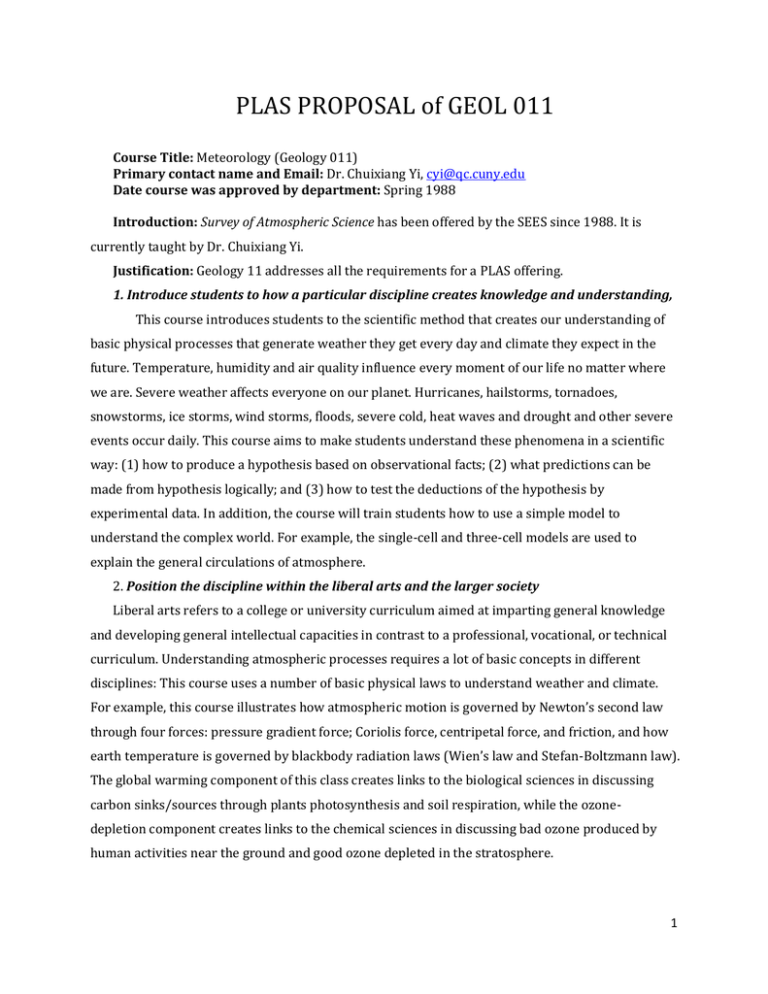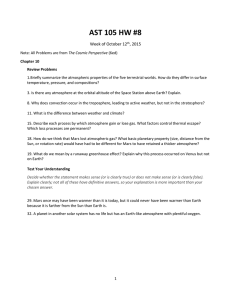PLAS PROPOSAL of GEOL 011
advertisement

PLAS PROPOSAL of GEOL 011 Course Title: Meteorology (Geology 011) Primary contact name and Email: Dr. Chuixiang Yi, cyi@qc.cuny.edu Date course was approved by department: Spring 1988 Introduction: Survey of Atmospheric Science has been offered by the SEES since 1988. It is currently taught by Dr. Chuixiang Yi. Justification: Geology 11 addresses all the requirements for a PLAS offering. 1. Introduce students to how a particular discipline creates knowledge and understanding, This course introduces students to the scientific method that creates our understanding of basic physical processes that generate weather they get every day and climate they expect in the future. Temperature, humidity and air quality influence every moment of our life no matter where we are. Severe weather affects everyone on our planet. Hurricanes, hailstorms, tornadoes, snowstorms, ice storms, wind storms, floods, severe cold, heat waves and drought and other severe events occur daily. This course aims to make students understand these phenomena in a scientific way: (1) how to produce a hypothesis based on observational facts; (2) what predictions can be made from hypothesis logically; and (3) how to test the deductions of the hypothesis by experimental data. In addition, the course will train students how to use a simple model to understand the complex world. For example, the single-cell and three-cell models are used to explain the general circulations of atmosphere. 2. Position the discipline within the liberal arts and the larger society Liberal arts refers to a college or university curriculum aimed at imparting general knowledge and developing general intellectual capacities in contrast to a professional, vocational, or technical curriculum. Understanding atmospheric processes requires a lot of basic concepts in different disciplines: This course uses a number of basic physical laws to understand weather and climate. For example, this course illustrates how atmospheric motion is governed by Newton’s second law through four forces: pressure gradient force; Coriolis force, centripetal force, and friction, and how earth temperature is governed by blackbody radiation laws (Wien’s law and Stefan-Boltzmann law). The global warming component of this class creates links to the biological sciences in discussing carbon sinks/sources through plants photosynthesis and soil respiration, while the ozonedepletion component creates links to the chemical sciences in discussing bad ozone produced by human activities near the ground and good ozone depleted in the stratosphere. 1 Of particular relevance to the larger society, the course illustrates the impacts of global warming, ozone depletion, and deforestation on society, such as issues raised by heat waves, cold waves, intensified hurricanes, and sea level rising. Most students who take the General Education curriculum are often confused if global warming and ozone depletion is anthropogenic or nature or both. Meteorology provides unique scientific foundation to understanding of these hot debate topics, and makes students in a good position to judge these issues themselves. 3. Address the goals defined for the particular areas of knowledge the course is designed to fulfill. The specific goals of this course are designed to fulfill are below: (1) Identify the primary elements that compose the atmosphere. (2) Describe the vertical structure of the atmosphere in terms of pressure, temperature and density. (3) Describe the factors affecting incoming solar radiation and outgoing terrestrial radiation in relation to the overall energy balance of the earth/atmosphere system. (4) Explain how the forces of motion act together to produce winds in the atmosphere. (5) Describe the processes related to cloud formation and precipitation including the role of atmospheric stability. (6) Identify characteristics of different air masses and describe the structure and nature of fronts. (7) Describe the basic characteristics of thunderstorms and hurricanes and identify the hazardous phenomena associated with each. (8) Identify methods of observing the atmosphere and explain how observations are used in atmospheric science. 4. Be global or comparative in approach This course must have a global outlook. The spatial scale of atmospheric motion is on a broad range. The large scale examples are the general circulations of atmosphere, monsoon occurrence, and hurricane evolution. The relative small scale examples are thunderstorms, tornados, sea/land breeze, shinook wind. While the basic principles that govern these phenomena may be the same, the ecological and landscape consequences are very different. For examples, tropical forests, grasslands, and desert are resulted from persistent influences of different prevailing weather systems over long time periods. 6. Engage students in active inquiry 2 The instructor of meteorology has recently emphasized on inquiry-oriented format, introducing knowledge by asking questions, encouraging students to actively answer and ask questions, or students answering students’ questions. This discussion format is to lead students to learn for themselves instead of what traditional meteorology courses present as facts to be memorized. For example: 1) To lead an interesting class discussion on adiabatic rising/sinking processes, the instructor writes two statements, "rising air cools" and "warm air rises," on the board and asking the students whether the statements are contradictory. 2) The concept of equilibrium is sometimes difficult for students to grasp. Place a glass of water on a table top and ask the students whether they think the temperature of the water in the glass is warmer, cooler or the same as the surroundings. Many will say it is the same. Ask the students whether they think there is any energy flowing into or out of the glass. With some encouragement, they will recognize that the water is slowly evaporating and that this represents energy flow out of the glass. Energy flowing out of the glass will cause the water's temperature to decrease. Will the water just continue to get colder and colder until it freezes? No, as soon as the water's temperature drops below the temperature of the surroundings, heat will begin to flow into the water. The rate at which heat flows into the glass will depend on the temperature difference between the glass and the surroundings. The water temperature will decrease until energy flowing into the glass balances the loss due to evaporation. 7. Reveal the existence and importance of change over time. Time is a very important concept in atmospheric science. Atmospheric motions at different scales have different life spans, ranging from a few minutes (small turbulent eddies) to a week or more (hurricanes, weather map features: high and low pressure areas and weather fronts). The time scale of climate fluctuations varies from season to 100 million years as indicated in the table below. Table: Cause of Climate fluctuations and approximate time lines. Cause of Climate Change Human effects on land surface Human effects on atmosphere Volcanism Solar variability Air-sea interaction Orbital variations Plate Tectonics Number of Years 1-100 1-100 1-1000 10-1000 1-100,000 10,000-100,000 100,000-100,000,000 3 Course materials, Assignments and Activities A syllabus of this course in fall 2007 is attached. Assessment: Standard College evaluations are administered as supplied. In addition, the standard Department evaluation is administered once a semester for a junior faculty member. Current instructor of this course is Dr. Chuixiang Yi who is a junior faculty member. Input from these evaluations has been valuable in improving the course. Administration: The department approved the original course description. The department, as a committee, periodically evaluates all our courses. Survey of Atmospheric Sciences has always been taught by a full time faculty member. 4







